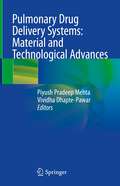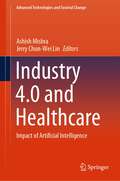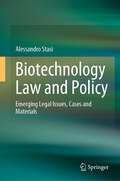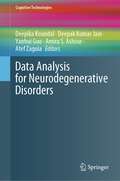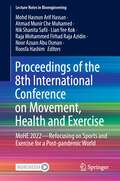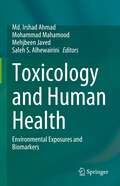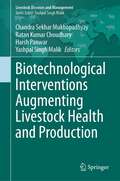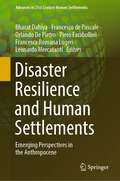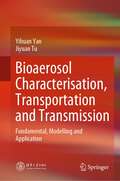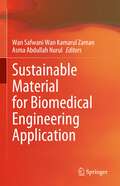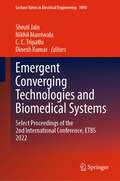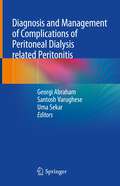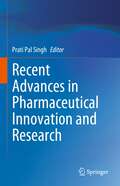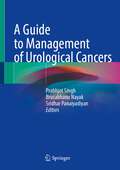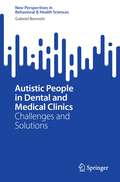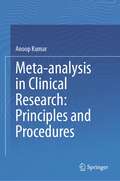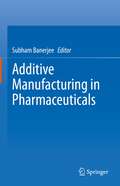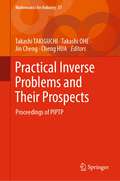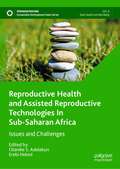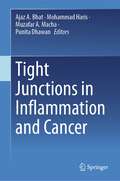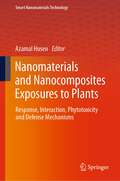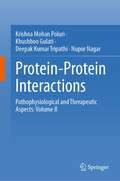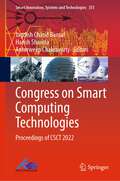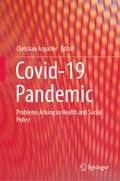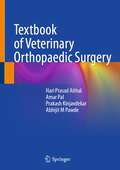- Table View
- List View
Pulmonary Drug Delivery Systems: Material and Technological Advances
by Piyush Pradeep Mehta Vividha Dhapte-PawarThis book provides an insight into state-of-art developments in pulmonary drug delivery systems. It comprises several chapters covering a wide range of promising technologies and novel materials explored for developing effective pulmonary drug delivery systems. The initial book chapters elucidate role of thin film freezing, supercritical fluid technology, nano-in-micro particles system, crystal-engineered microstructures and porous particles in pulmonary drug delivery. The subsequent book chapters elaborate on various functional excipients such as chitosan, cyclodextrins, and Vitamin E-TPGS to attain local and systemic therapeutic action. There are book chapters focused on diverse novel carrier systems such as hydrogels, quantum dots, metal-organic framework, and prodrug approach. Additionally, book also contains chapters, exclusively dedicated to biologicals and numerical simulation in pulmonary therapeutics. The book chapters follow a sequential order, beginning with the pulmonary relevance of technology or polymeric materials, carrier synthesis schemes, current technical state-of-art, along with clinical, industrial, and regulatory aspects. Each chapter contains a future perspective section that will systematically reflect the current state of advances in pulmonary drug delivery. It also offers a practical basis for audience to understand the design and function of the delivery systems for better therapeutic outcomes. The book provides balanced views by considering the investigations from various scientific domains and industrial knowledge. Briefly, this book aims to collect, analyse, and bring together the latest developments in pulmonary drug delivery with more focus on materials and technologies. Indeed, this book is a valuable source for readers and researchers who wish to learn more about the advances in pulmonary drug delivery systems.
Industry 4.0 and Healthcare: Impact of Artificial Intelligence (Advanced Technologies and Societal Change)
by Ashish Mishra Jerry Chun-Wei LinThis book presents different stages of Industrial Revolution in artificial intelligence and its impact on industry 4.0 and Healthcare. It contains chapters prepared for the industrial landscape which is being transformed to the fourth stage with the rise of autonomous robots, contemporary automation, cyber-physical systems, the Internet of things, and the Internet of services for examining the circumstances of health care system for the future. It highlights the emerging trends in integration of different intelligent manufacturing systems and advanced information technologies. Additionally, understanding of the real-world issues using artificial intelligence and the solutions discussed in this book help the enormous numbers of techniques which can be applied for effective diagnosis and predicting diseases from health care data.
Biotechnology Law and Policy: Emerging Legal Issues, Cases and Materials
by Alessandro StasiThis book covers an extensive range of issues raised by biotechnological advancements from a regulatory perspective. Written in a clear and readable style, its main objective is to give readers an idea of the relationship between biotechnology and law. Biotechnology advancements and their ethical, moral, economic, and social implications in different fields and the consequential normative demands on the law are crucial to this book. The chapters cover a multitude of themes and some of the most important legal issues arising in relation to biotechnology, including the historical development of a legal framework sufficient to protect public safety, the current biotechnology regulatory system, and the rules directing the primary agencies that regulate the products of biotechnology, namely the US Food and Drug Administration, the US Department of Agriculture, and the US Environmental Protection Agency, patents and IP rights in biotechnology, the regulation of human genome editing and its impact on health research, law and emerging genome editing technologies from recombinant DNA to CRISPR/Cas9, the development of legal principles to protect property rights in the human body and allow the efficient use of human tissue, organs, DNA, and cell-lines in medical research, and legal issues arising from the use of genetic engineered plants and animals.Presenting arguments that have been drawn from careful examination of various international documents and decisions made by legal institutions and judicial bodies, this book would be a valuable read for practitioners as well as academics of biotechnology law.
Data Analysis for Neurodegenerative Disorders (Cognitive Technologies)
by Deepika Koundal Deepak Kumar Jain Yanhui Guo Amira S. Ashour Atef ZaguiaThis book explores the challenges involved in handling medical big data in the diagnosis of neurological disorders. It discusses how to optimally reduce the number of neuropsychological tests during the classification of these disorders by using feature selection methods based on the diagnostic information of enrolled subjects. The book includes key definitions/models and covers their applications in different types of signal/image processing for neurological disorder data. An extensive discussion on the possibility of enhancing the abilities of AI systems using the different data analysis is included. The book recollects several applicable basic preliminaries of the different AI networks and models, while also highlighting basic processes in image processing for various neurological disorders. It also reports on several applications to image processing and explores numerous topics concerning the role of big data analysis in addressing signal and image processing in various real-world scenarios involving neurological disorders.This cutting-edge book highlights the analysis of medical data, together with novel procedures and challenges for handling neurological signals and images. It will help engineers, researchers and software developers to understand the concepts and different models of AI and data analysis. To help readers gain a comprehensive grasp of the subject, it focuses on three key features:● Presents outstanding concepts and models for using AI in clinical applications involving neurological disorders, with clear descriptions of image representation, feature extraction and selection.● Highlights a range of techniques for evaluating the performance of proposed CAD systems for the diagnosis of neurological disorders.● Examines various signal and image processing methods for efficient decision support systems. Soft computing, machine learning and optimization algorithms are also included to improve the CAD systems used.
Proceedings of the 8th International Conference on Movement, Health and Exercise: MoHE 2022—Refocusing on Sports and Exercise for a Post-pandemic World (Lecture Notes in Bioengineering)
by Mohd Hasnun Arif Hassan Ahmad Munir Che Muhamed Nik Shanita Safii Lian Yee Kok Raja Mohammed Firhad Raja Azidin Noor Azuan Abu Osman Roosfa HashimThis book gathers papers presented at the 8th International Conference on Movement, Health and Exercise (MoHE 2022) with the conference theme "Enhancing Health and Sports Performance by Design". The topics covered include exercise science; human performance; physical activity and health; sports medicine; sports nutrition; management and sports studies; and sports engineering and technology. Its content is of interest to sports scientists, researchers and practitioners from various sports and exercise sub-disciplines.
Toxicology and Human Health: Environmental Exposures and Biomarkers
by Md. Irshad Ahmad Mohammad Mahamood Mehjbeen Javed Saleh S. AlhewairiniThis contributed volume brings out a comprehensive collection of information on environmental toxicology, its impact on living organisms in general and human health in particular. The main focus of this book is to address human health issues and risk assessment. Toxicological studies help in understanding the impact of harmful substances including both natural and synthetic chemicals on organisms and their environment. Contributions in the title include both laboratory and field based studies with a focus on human health. Moreover, day by day, there is an increase in the range of chemicals from pharmaceutical and other industries, agricultural runoffs, medicine, and many other sources which continuously contribute to the earth's chemical load. Almost all the countries are facing great difficulties in responding to the crucial and immediate need for effective management of such contaminants. The title compiles studies in regards to environmental toxicology and its effect on human health. This book provides critical information and knowledge that can be used by regulatory agencies, decision-makers, policy makers, graduate and post-graduate students, researchers, environmental toxicologists, etc, and others to put programs and policies in place to limit our exposures to these substances thereby preventing or reducing the likelihood that a disease or other negative health outcomes would occur.
Biotechnological Interventions Augmenting Livestock Health and Production (Livestock Diseases and Management)
by Chandra Sekhar Mukhopadhyay Ratan Kumar Choudhary Harsh Panwar Yashpal Singh MalikThis book comprehensively discusses the applications of molecular genetics, functional and structural genomics, and proteomics vis-a-vis bioinformatics, artificial intelligence, and robotics in livestock healthfulness and productivity. It reviews the biotechnological approaches in veterinary sciences for increasing productivity and resistance to disease. The book emphasizes the approaches based on artificial intelligence to analyze the data collected on animals, pathogens, and their environment. It underscores artificial intelligence applications in disease diagnosis, epidemiological studies, and detecting biological phenomena, including heat-detection, pregnancy, docility, and infections. Further, the book examines the genomics and proteomics approaches for understanding the gut microbiota and the role of pathogen-host interactions in animal health and disease. Lastly, it explores both pathogenic and non-pathogenic microbial transfer between humans, animals, and the environment across one health spectrum.
Disaster Resilience and Human Settlements: Emerging Perspectives in the Anthropocene (Advances in 21st Century Human Settlements)
by Bharat Dahiya Francesco De Pascale Orlando De Pietro Piero Farabollini Francesca Romana Lugeri Leonardo MercatantiThis book presents emerging perspectives on disaster resilience and human settlements in the larger context of the Anthropocene. The chapters explore urban and rural perspectives focusing on the current and emerging perspectives on disaster resilience through a holistic approach, involving scientists, humanists, planners, policymakers, and professionals in the global debate.
Bioaerosol Characterisation, Transportation and Transmission: Fundamental, Modelling and Application
by Yihuan Yan Jiyuan TuThis book aims to predict and model the transport of bioaerosols, identify their transmission characteristics, and assess occupants’ infection risks. Although existing epidemiological books provide fundamental infection rate of existing diseases, the ability of predicting emerging disease transmission in the air and assessing occupants’ infection risks to the bioaerosols is significantly lacking. This book is considered as a professional book that provides in-depth discussion of the aforementioned issues and provides potential approaches to solve these issues would be highly demanded by readers in this emerging research field. This book offers essential and systematic analysis on the fate of bioaerosols from their release in the air to the final destination in human’s respiratory systems through direct 3D visualizations techniques. It also provides quantifiable method to assess each occupant’s infection risks to the infectious bioaerosols in indoor environments. The readers will gain essential fundamental characteristics of bioaerosols (active time, viability, etc.) and will gain the advanced skills on how to integrate these properties into numerical modeling and assess the occupants’ exposure risks.
Sustainable Material for Biomedical Engineering Application
by Wan Safwani Wan Kamarul Zaman Asma Abdullah NurulSustainable Material for Biomedical Engineering Application discusses current interdisciplinary approaches in the development of materials and their derivatives that are sustainable for biomedical engineering application. Recent advancement of materials research has shown to have great impact on biomedical and clinical applications. With potential for sustainability, the materials discussed and illustrated in this book, may have the ability to increase and contribute to wider therapeutic options for patients. On the other hand, with the advancement in materials technology, they also have positive impacts in terms of reproducibility and more cost-effective manufacturing solutions for biomedical engineering industry. Some of the main aspects covered in this book are utilisation of human waste, food waste and green technology approach for materials in biomedical engineering applications such as tissue engineering, 3D printing and biosensing. A team of experts from various disciplines share recent advances that provide details and integrates different approaches to sustainable materials development. This book is intended for academicians, researchers, students and industrial players in the field of materials and biomedical engineering.
Emergent Converging Technologies and Biomedical Systems: Select Proceedings of the 2nd International Conference, ETBS 2022 (Lecture Notes in Electrical Engineering #1040)
by Shruti Jain Nikhil Marriwala C. C. Tripathi Dinesh KumarThe book contains proceedings of the International Conference on Emergent Converging Technologies and Biomedical Systems ETBS 2022. It includes papers on wireless multimedia networks, green wireless networks, electric vehicles, biomedical signal processing and instrumentation, wearable sensors for health care monitoring, biomedical imaging, & bio-materials, modeling and simulation in medicine biomedical, and health informatics. The book will serve as a useful guide for educators, researchers, and developers working in the area of signal processing, imaging, computing, instrumentation, artificial intelligence, and their related applications. This book will also provide support and aid to the researchers involved in designing the latest advancements in healthcare technologies.
Diagnosis and Management of Complications of Peritoneal Dialysis related Peritonitis
by Georgi Abraham Santosh Varughese Uma SekarThis book is unique in addressing the management and complications of PD-related peritonitis to reduce morbidity and mortality. It addresses the measures to prevent peritonitis, types of tools used for diagnosis, including molecular techniques, the focus of microbiologists for educating peers, catheter-related issues such as catheter care, exit site, and tunnel infection, catheter removal, reimplantation techniques, nurses' role, nutrition aspects, surgical methods and pediatric peritoneal dialysis, peritonitis with its uniqueness in detail. Each chapter starts with a case scenario and pictures related to the branch by the contributors' experience.This book is helpful for physicians, nurses, technicians, microbiologists, ID trainees and consultants, nephrology trainees, nephrologists, and surgeons involved in PD care.
Recent Advances in Pharmaceutical Innovation and Research
by Prati Pal SinghThis book covers several important aspects of pharmaceutical research and innovations. It presents important topics on drug delivery, novel microsponge, nanocrystals, polymeric nanoparticles, peptide synthesis, biopharmaceuticals, pharmacodynamics, yeast flocculation, neuromodulators, innovative drug discovery, pharmacoinformatics, aminoquinoline, thiourea crystals for API synthesis, FDCs and formulations research, ayurveda and natural products, and innovations to militate anti-microbial resistance (AMR). A chapter is devoted to the applications of Artificial Intelligence and Machine Learning in diverse sectors of the pharmaceutical industry, including drug discovery and development, drug repurposing, and improving pharmaceutical productivity. The book also reviews the role of pharmacogenomics and pharmacogenetics in drug development and precision medicine. Further, the book presents an updated summary of recent advances in the fields of nanomedicines and nano-based drug delivery systems. This book is useful to pharmaceutical sciences students, researchers, educators, and professionals in the pharmaceutical industry to understand the intricacies of new drug research and innovations.
A Guide to Management of Urological Cancers
by Prabhjot Singh Brusabhanu Nayak Sridhar PanaiyadiyanThe book provides comprehensive review of common uro-oncology cases mainly focusing on its management aspect. It includes diagnosis and clinical staging, surgical management, pathological staging, adjuvant treatment and follow up. It provides current evidence-based approaches for the management of common urological malignancies. All the chapters are written uniformly in a simple yet informative manner by experts in their respective fields. It contains well-prepared illustrations, relevant clinical images and flowcharts. The book is helpful for practicing urologists, uro-oncologists, oncologists as well as urology trainees, uro-oncology fellows in providing a holistic approach to cancer patients. It helps them to develop critical thinking and encourage discussion toward improving the overall care of the patients.
Autistic People in Dental and Medical Clinics: Challenges and Solutions (New Perspectives in Behavioral & Health Sciences)
by Gabriel BennettWith 1 in 44 people now being diagnosed as autistic, there is a view that clinical environments should be “autistic friendly”. However, despite this expectation, medical and dental students are rarely taught how they can make their future clinical workplaces comfortable for autistic patients. Similarly, allied health professional, such as occupational therapists and psychologists, are also not taught this information. Due to this lack of knowledge, each day countless autistics and their families are exposed to potentially stressful clinical situations that can jeopardise the delivery of effective treatment. To help mitigate this situation, this book will give university students as well as established healthcare professionals an understanding of how they can assist autistic patients in clinical settings.This book is more than just providing strategies that aspiring and established healthcare professionals can use to make their clinical workplaces more accommodating for autistics and their families. It will also present a synopsis of the literature about the challenges and experiences that autistic patients have had in dental and medical settings. Such information can provide the reader with a greater understanding about what it is like to be autistic and receive medical and/or dental treatment. This synopsis will also illustrate the current gaps in our knowledge about this topic.
Meta-analysis in Clinical Research: Principles and Procedures
by Anoop KumarThis book provides conceptual information on the various processes involved in meta-analysis. It examines the importance of meta-analysis for the analyses of clinical data to draw a valid conclusion using suitable software. The initial sections of the book introduce meta-analysis, how to perform a systematic literature review (SLR), quality assessment of studies, extraction, and analysis of data. The subsequent section of the book contains information on advanced topics including, meta-regression, network meta-analysis, issues, mistakes, and future perspectives. In summary, the book provides a statistical method for combining the results of different studies on the same topic and resolving conflicts among studies. This book is written with the intent to allow a wide range of readers including students, researchers, and health care professionals, including physicians, nurses, pharmacists, and paramedical, and is also helpful for a beginner who would like to do a meta-analysis.
Additive Manufacturing in Pharmaceuticals
by Subham BanerjeeThis book presents the different 3D/4D printing technological applications of Additive Manufacturing (AM) in Pharmaceutical Sciences. The initial chapter provides the historical perspective and current scenario of AM in pharmaceuticals. The book further discusses about different 3D printing platform technologies such as FDM, SLA, SLS, SSE, Ink-jet & binder jet principles & applications in developing advanced drug delivery systems. It also covers the methodology, materials for AM and important parameters associated with these platform technologies. The book highlights the progress and practical applications of 4D-printing technology in healthcare & pharmaceuticals fraternity as well including the essence of bioprinting in pharmaceuticals. Finally, the book reviews the regulatory guidelines, perspectives, and integration of Artificial Intelligence (AI)/Machine learning (ML) in pharmaceutical AM. This book is indeed a valuable resource for students, researchers/scholars, young start-ups/entrepreneurs, and pharmaceutical professionals by providing thorough detailing about AM in Pharmaceuticals.
Practical Inverse Problems and Their Prospects: Proceedings of PIPTP (Mathematics for Industry #37)
by Takashi Takiguchi Takashi Ohe Jin Cheng Cheng HuaThis book comprises select proceedings of the workshop “Practical inverse problems and their prospects” held online by zoom, from Mar 2nd to Mar. 4th, 2022, supported by Institute of Mathematics for Industry, Kyushu University focusing on cutting-edge research carried out in the areas of practical inverse problems based on industry-academia and interdisciplinary collaborations.Various themes on practical inverse problems covered in this book are medical imaging, non-destructive and non-invasive inspections, viscoelastic waves, remote sensing, infrared light tomography, maintenance of infrastructure, and so on, and mathematical theories in inverse problems are also handled in these proceedings.All papers in this book are written by qualified authors in the practical inverse problems area and also the papers are newly announced. Readers can get leading-edge information on practical inverse problems.
Reproductive Health and Assisted Reproductive Technologies In Sub-Saharan Africa: Issues and Challenges (Sustainable Development Goals Series)
by Olanike S. Adelakun Erebi NdoniThis book focuses on reproductive health rights and assisted reproductive technologies (ART) in sub-Saharan Africa. Each chapter is connected to the other by focusing on different aspects of ART as a means of achieving conception.Topics such as regulation of ART practices, surrogacy and specific aspects of ART, which are gradually becoming acceptable but largely unregulated in Africa, promises to be of interest to scholars, researchers and fertility practitioners. Research in the book take a rights based approach and ethical analysis of ART practice in sub-Saharan Africa by authors from diverse backgrounds bringing together law and society perspectives.Readers stand to gain new knowledge on the societal, legal, medical and psychological requirements, effects and challenges of reproductive health rights and ART in the African context. The book is also relevant to UN Sustainable Development Goal 3: Good Health and Well-being, given that it promotes and advocates for access to reproductive healthcare for persons who have difficulty or are unable to conceive without medical assistance.
Tight Junctions in Inflammation and Cancer
by Ajaz A. Bhat Mohammad Haris Muzafar A. Macha Punita DhawanThis book provides an updated account of tight junctions of different epithelia and endothelia and addresses their anatomy, biochemistry, physiology, synthesis, assembly, and modulation. It also discusses the relationship between molecular structure, function, regulation, posttranslational modifications of tight junction proteins and their role in gut microbiota maintenance, epithelial-mesenchymal transition, and intestinal barrier dysfunction-associated disorders important for the progression of human cancers. This book presents the pathological alterations of tight junctions at the blood-brain barrier that intensify or even initiate neurological dysfunction. Further, it reviews the significance of tight junctions and tight junction proteins in cancer development, infectious diseases, allergic reactions, and autoimmune disorders. Lastly, it highlights strategies for modulating tight junctions to enhance drug availability and organ deposition. This book is immensely useful for basic, translational, clinical, and interdisciplinary cancer researchers, practicing oncologists, and immunologists.
Nanomaterials and Nanocomposites Exposures to Plants: Response, Interaction, Phytotoxicity and Defense Mechanisms (Smart Nanomaterials Technology)
by Azamal HusenThis book looks at the interaction between plants and nanomaterials/nanocomposites, and their effects ecology, the food chain and human health. It focuses on nanomaterials/nanocomposites phytotoxicity, which is an important precondition to promote the application of nanotechnology and to avoid the potential ecological risks. It describes the influencing factors of nanotoxicity of nanomaterials and the mechanisms of these toxic effects and defense mechanisms in plants. The chapters in this book are written by internationally renowned researchers and professionals and provides exciting and remarkable information (on the above-mentioned topics) to the scientist, researcher and student working field of plant biology, agricultural science, nanobiotechnology, plant biochemistry, plant physiology, plant biotechnology and many other interdisciplinary subjects.
Protein-Protein Interactions: Pathophysiological and Therapeutic Aspects: Volume II
by Krishna Mohan Poluri Khushboo Gulati Deepak Kumar Tripathi Nupur NagarThe second volume of the book-Protein-Protein Interactions (PPIs) provides an overview of various protein-protein interactions (PPIs) that are involved in various human diseases including cancer, neurodegenerative diseases, immune diseases, and inflammation. It summarizes the structure and ligand-based drug designing approaches for the discovery of small molecules that can inhibit PPIs in these diseases. The book discusses different computational and experimental tools that are used to determine the anomalous interactions underlying the diseases. Lastly, it also reviews the classical interactions between pathogens and hosts that are responsible for the pathophysiology of infectious diseases.
Congress on Smart Computing Technologies: Proceedings of CSCT 2022 (Smart Innovation, Systems and Technologies #351)
by Jagdish Chand Bansal Harish Sharma Antorweep ChakravortyThis book presents high-quality research papers presented at Congress on Smart Computing Technologies (CSCT 2022) organized by SAU Center for Research and Innovative Learning (SCRIL), South Asian University, India, from 3–4 December 2022. The book extensively covers recent research in algorithms for smart computing, AI and machine learning in smart computing, edge computing algorithms, adversarial networks and autoencoders, data visualization, data mining, data analytics, machine learning, game theory, high-performance computing, mobile and ubiquitous platforms for smart environments, cloud/edge/fog computing technologies for smart systems, Internet of Things (IoT) and industrial IoT technologies for smart systems, smart device and hardware, security, privacy, and economics in smart environments, big data, healthcare informatics, smart precision agriculture, smart transportation, social network analysis, and human–computer interaction.
Covid-19 Pandemic: Problems Arising in Health and Social Policy
by Christian AspalterThis book presents an overview of social problems and health problems that arose out of, or were flared up by, the global COVID-19 pandemic. It addresses most vital problems in developed and developing countries from literally around the world, by top country experts in their respective fields of study. The book debates first certain overall thematic topics and then analyzes a number of key country case studies. Apart from a set of key theme/problem-based chapters, the country case studies from major-hit countries in the world are yet another highlight of the book. They also feature, in addition to analyzing the pandemic and policy responses per se, one extra special focal point each. The book hence covers the core of most severe social problems, including health problems, that have been spurred or set off by the COVID-19 pandemic. An overall theory chapter that uses a global data analysis and a short theoretical appraisal on the 'human face' of the Pandemic is also offered at the beginning of book, to bring back humanity and human decency (i.e. decency of the human condition) into the scientific debate as well as policy making arena, which is utterly needed at this point of human development.
Textbook of Veterinary Orthopaedic Surgery
by Hari Prasad Aithal Amar Pal Prakash Kinjavdekar Abhijit M PawdeThis textbook emphasizes the fundamentals of bone fracture and its fixation, including advanced techniques of osteosynthesis in both small and large animals. Various fracture fixation techniques and devices have been described in simple language with the help of sketches and photographs. The chapter on the basic considerations in fracture fixation narrates bone structure and types, bone development and growth regulation, types of fracture and fracture healing, first aid and emergency treatment, selection of fracture fixation technique, anesthetic management, and fracture fixation implants and instruments. The book highlights principles of different external, internal, and external skeletal fixation techniques. It also presents various basic and advanced techniques used to manage specific fractures in different bones, separately for small and large animal patients. It also includes specific topics like fracture fixation in young, osteoporotic, and avian bones, open fracture management, bone grafts and scaffolds, and fracture fixation complications. Towards the end, the book elucidates miscellaneous but essential topics in veterinary orthopedics such as metabolic bone diseases, antebrachial bone deformities, joint luxations, arthritis, common tendon, and ligament injuries, bone tumors, and physiotherapy and rehabilitation of patients. This textbook is essential reading for veterinary students, practitioners, and researchers working in veterinary orthopedic surgery.
